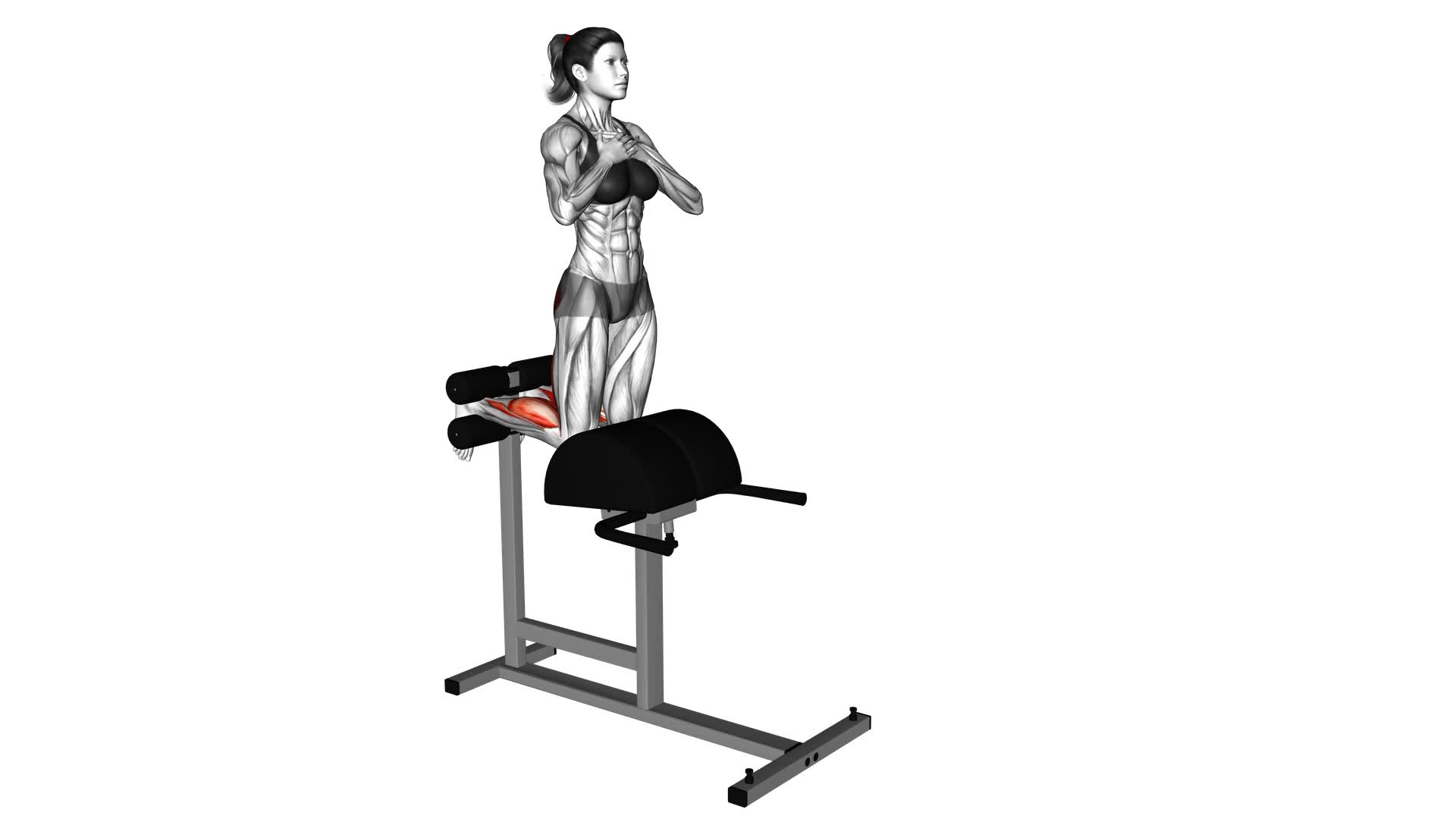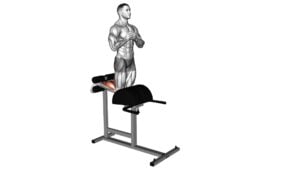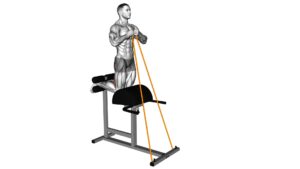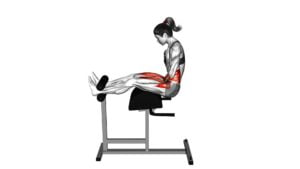Glute Ham Raise (VERSION 2) (female) – Video Exercise Guide & Tips

Are you looking to strengthen your glutes and hamstrings? The Glute Ham Raise (Version 2) is the perfect exercise for you.
Watch This Exercise Video
In this video exercise guide, we'll show you the proper form and equipment needed to perform this exercise effectively. We'll also provide variations and progressions to keep challenging yourself.
Avoid common mistakes and get tips for incorporating the Glute Ham Raise (Version 2) into your workout routine.
Get ready to sculpt and strengthen those lower body muscles!
Key Takeaways
- The Glute Ham Raise (VERSION 2) targets and strengthens the glutes, hamstrings, and lower back muscles.
- Incorporating the exercise into a regular workout routine can improve core stability, posture, and enhance athletic performance.
- Proper form, including engaging the core, keeping the back straight, and squeezing the glutes at the top of the movement, is crucial for effective activation of targeted muscles.
- Variations and progressions can be added to challenge muscles, improve strength and stability, and add variety to the routine.
Benefits of the Glute Ham Raise (VERSION 2)
Experience the numerous benefits of the Glute Ham Raise (VERSION 2) as it targets and strengthens your glutes, hamstrings, and lower back muscles. When performed correctly, this exercise can provide significant advantages for your overall fitness and athletic performance.
One key benefit of the Glute Ham Raise (VERSION 2) is its ability to improve your core stability and posture. By engaging your glutes, hamstrings, and lower back muscles, this exercise helps to strengthen the muscles responsible for maintaining proper alignment and balance.
In addition, the Glute Ham Raise (VERSION 2) can also enhance your athletic performance by increasing your power and explosiveness. By targeting the posterior chain, including the glutes and hamstrings, this exercise can improve your strength and speed. Proper breathing is crucial during this exercise, as it helps to stabilize your core and maintain proper form. Remember to inhale deeply before starting the movement and exhale as you lift your body back up.
To maximize the benefits of the Glute Ham Raise (VERSION 2), it's important to incorporate it into your regular workout routine. Start by performing this exercise once or twice a week and gradually increase the frequency and intensity as your strength improves. Remember to always listen to your body and adjust the exercise accordingly.
Now that you understand the benefits, it's time to learn the proper form for the Glute Ham Raise (VERSION 2).
Proper Form for the Glute Ham Raise (VERSION 2)
To properly perform the Glute Ham Raise (VERSION 2), start by positioning yourself on the glute ham raise machine with your feet securely fastened and your knees bent at a 90-degree angle.
Now, let's dive into the proper execution and muscle activation for this exercise:
- Engage your core: Before you begin the movement, make sure to activate your core muscles by pulling your belly button in towards your spine. This will help stabilize your body throughout the exercise.
- Lower yourself slowly: Slowly lower your upper body towards the ground while keeping your back straight and your glutes engaged. Make sure to control the movement and avoid any sudden jerks or momentum.
- Squeeze your glutes at the top: As you raise your body back up to the starting position, focus on squeezing your glutes at the top of the movement. This will help maximize the activation of your glute muscles.
By following these proper form guidelines, you can ensure that you're performing the Glute Ham Raise (VERSION 2) with correct technique and effectively activating the targeted muscles.
Remember to listen to your body and adjust the resistance level as needed to challenge yourself appropriately.
Equipment Needed for the Glute Ham Raise (VERSION 2)
To perform the Glute Ham Raise (VERSION 2), you'll need a GHR machine or a glute ham raise bench. These pieces of equipment provide the necessary stability and support for the exercise.
If you don't have access to a GHR machine or bench, you can try alternative exercises that target the same muscle groups, such as Romanian deadlifts or hip thrusts.
Incorporating the Glute Ham Raise (VERSION 2) into your workout routine can help strengthen your glutes, hamstrings, and lower back while improving your overall posterior chain strength and stability.
Necessary Equipment for GHR
You will need certain equipment for performing the Glute Ham Raise (VERSION 2). Here are the necessary equipment and alternatives to GHR:
- Glute Ham Developer (GHD): This is the main equipment required for performing the Glute Ham Raise. It's specifically designed to target the glutes, hamstrings, and lower back muscles.
- Adjustable Foot Plate: The GHD should have an adjustable foot plate that can be positioned to accommodate different user heights and leg lengths. It provides stability and support during the exercise.
- Padding or Knee Pads: To minimize discomfort and pressure on the knees, it's recommended to use padding or knee pads. This will help protect the knees and allow for a more comfortable execution of the exercise.
If you don't have access to a Glute Ham Developer, there are alternative exercises that can target the same muscle groups, such as Romanian Deadlifts, Nordic Hamstring Curls, or Swiss Ball Leg Curls. These exercises can be performed with minimal equipment and still provide a challenging workout for the glutes and hamstrings.
Alternatives to GHR
If you don't have access to a Glute Ham Developer, there are alternative exercises that can target the same muscle groups as the Glute Ham Raise (VERSION 2) and require minimal equipment. Training without equipment is still possible.
One option is the Nordic Hamstring Curl, where you kneel on a soft surface and have a partner hold your ankles while you lower your torso towards the ground and then raise back up using your hamstrings.
Another alternative is the Swiss Ball Hamstring Curl, where you lie on your back with your feet on a Swiss ball and lift your hips off the ground while curling the ball towards your glutes.
These exercises can provide similar benefits to the Glute Ham Raise (VERSION 2) and can be incorporated into your training routine.
Benefits of GHR
The Glute Ham Raise (VERSION 2) requires specific equipment, such as a Glute Ham Developer, to effectively target the desired muscle groups. Here are the benefits of using this equipment for the Glute Ham Raise:
- Avoiding injury: The Glute Ham Developer provides stability and support, reducing the risk of injury during the exercise. It allows you to maintain proper form and alignment, minimizing strain on your joints.
- Muscle activation: The Glute Ham Raise targets the glutes, hamstrings, and lower back muscles. By using the Glute Ham Developer, you can fully engage these muscles, leading to increased strength and stability in the posterior chain.
- Enhanced performance: Incorporating the Glute Ham Raise into your workout routine can improve your performance in activities that require lower body strength and power, such as running, jumping, and lifting. It helps to build a strong foundation for athletic movements.
Variations and Progressions for the Glute Ham Raise (VERSION 2)
To enhance your glute ham raise (VERSION 2) workout, incorporate variations and progressions to challenge your muscles and improve your strength and stability. There are several variations you can try to target different muscle groups and add variety to your routine.
One variation is the single-leg glute ham raise, where you perform the exercise with one leg lifted off the ground. This variation increases the difficulty and places more emphasis on the working leg.
Another variation is the banded glute ham raise, where you add a resistance band around your shoulders or ankles to increase the resistance and make the exercise more challenging.
Progressions for the glute ham raise include increasing the range of motion by lowering your torso closer to the ground, or adding weight by holding a dumbbell or plate against your chest. These progressions help to continuously challenge your muscles and promote strength gains.
Now that you know how to vary and progress your glute ham raise workouts, let's discuss common mistakes to avoid during the exercise.
Common Mistakes to Avoid During the Glute Ham Raise (Version 2)
To perform the Glute Ham Raise (Version 2) correctly, proper form is of utmost importance. Avoiding lower back strain is crucial, so make sure to engage your core and maintain a neutral spine throughout the exercise.
Additionally, paying attention to your breathing technique can help you maximize the effectiveness of the movement.
Proper Form Importance
When performing the Glute Ham Raise (Version 2), it's crucial for you to be mindful of the common mistakes to avoid. Proper form is of utmost importance as it not only maximizes the benefits of the exercise but also helps in avoiding injuries.
Here are three tips to ensure proper form during the Glute Ham Raise (Version 2):
- Maintain a neutral spine: Avoid arching or rounding your back during the movement. Keep your spine in a neutral position to protect your lower back and engage your glutes and hamstrings effectively.
- Control the descent: Lower your body down slowly and under control. Avoid letting gravity take over, as this can lead to excessive stress on your hamstrings and increase the risk of injury.
- Engage your core: Keep your core muscles tight and activated throughout the exercise. This will provide stability to your body and help maintain proper form.
Avoiding Lower Back Strain
Maintaining proper form and avoiding common mistakes is essential to prevent lower back strain during the Glute Ham Raise (Version 2).
By taking the necessary precautions, you can effectively strengthen your glutes and hamstrings while minimizing the risk of lower back pain.
One common mistake to avoid is arching your lower back excessively. This puts unnecessary strain on the lumbar spine and can lead to discomfort or injury. Instead, focus on maintaining a neutral spine throughout the exercise.
Another mistake to watch out for is using momentum to lift your body. This takes away from the targeted muscles and increases the strain on your lower back.
Remember to engage your glutes and hamstrings to perform the exercise correctly and effectively.
Breathing Technique Tips
To ensure proper breathing technique during the Glute Ham Raise (Version 2), focus on exhaling as you lift your body up and inhaling as you lower it back down. This will help you maintain control and activate the correct muscles throughout the exercise. Here are three important tips to keep in mind:
- Exhale during the concentric phase: As you lift your body up, exhale forcefully through your mouth. This will help engage your core muscles and provide stability during the movement.
- Inhale during the eccentric phase: As you lower your body back down, take a deep breath in through your nose. This helps provide oxygen to your muscles and prepares them for the next repetition.
- Avoid shallow breathing: Make sure you take full, deep breaths during each phase of the exercise. Shallow breathing can lead to tension and restrict the activation of your glutes and hamstrings.
Tips for Incorporating the Glute Ham Raise (Version 2) Into Your Workout Routine
To effectively incorporate the Glute Ham Raise (Version 2) into your workout routine, start by performing three sets of ten reps. This exercise can be a great addition to your routine, especially if you're looking to incorporate it into HIIT workouts or use it for glute activation before squats.
When incorporating the Glute Ham Raise (Version 2) into your HIIT workouts, you can use it as a challenging lower body exercise that targets your hamstrings, glutes, and core. It can be performed as a standalone exercise or in combination with other exercises to create a circuit-style workout.
Additionally, performing the Glute Ham Raise (Version 2) before squats can help activate your glutes and hamstrings, allowing for better engagement during your squat movements. This can lead to improved performance and reduced risk of injury.
Remember to maintain proper form throughout the exercise. Keep your core engaged, squeeze your glutes at the top of the movement, and control the descent to fully engage your muscles.
Incorporating the Glute Ham Raise (Version 2) into your workout routine can bring a new level of challenge and activation to your lower body workouts. Give it a try and see the benefits for yourself.
Frequently Asked Questions
How Many Sets and Reps Should I Do for the Glute Ham Raise (Version 2) to See Results?
To see results from the glute ham raise (version 2), you should aim for a good balance of sets and reps. Start with 3 sets of 10-12 reps and gradually increase the intensity as you get stronger.
This exercise targets your glutes, hamstrings, and lower back, helping to improve strength, stability, and athletic performance.
Incorporating glute ham raise variations into your routine can provide additional benefits such as increased muscle activation and improved posture.
Can the Glute Ham Raise (Version 2) Be Modified for Beginners or Those With Lower Back Issues?
Yes, the Glute Ham Raise (version 2) can be modified for beginners or those with lower back issues. There are modifications available that can help you perform this exercise safely and effectively.
It's important to consult with a fitness professional or physical therapist who can guide you on the proper modifications based on your specific needs. By making adjustments to the technique or using additional support, you can still engage your glutes and hamstrings without putting excessive strain on your lower back.
Will the Glute Ham Raise (Version 2) Help Improve My Sprinting Speed?
Yes, the glute ham raise (version 2) can help improve your sprinting speed. This exercise specifically targets and strengthens your glutes and hamstrings, which are important muscles for generating power and speed in your lower body. By regularly incorporating the glute ham raise into your training routine, you can enhance your sprinting performance.
Additionally, there are various glute ham raise variations that can further challenge and benefit your muscles. Make sure to follow the video exercise guide and tips for proper form and technique.
Is It Necessary to Use a Glute Ham Raise Machine for This Exercise, or Can It Be Done With Alternative Equipment?
Yes, it's possible to perform the glute ham raise exercise without a machine. Using alternative equipment like resistance bands or a stability ball can help you achieve similar benefits.
The glute ham raise targets your glutes, hamstrings, and lower back, improving your overall strength and stability. Incorporating this exercise into your routine can enhance your athletic performance and help prevent injuries.
Consider consulting a fitness professional to ensure proper form and technique.
Can the Glute Ham Raise (Version 2) Be Performed at Home Without Any Special Equipment?
Yes, the glute ham raise (version 2) can be performed at home without any special equipment. You don't need a glute ham raise machine or any specific gear. You can use alternative equipment like a stability ball or a bench to support your body.
Conclusion
In conclusion, the Glute Ham Raise (Version 2) is a highly effective exercise for targeting and strengthening the glutes and hamstrings. By maintaining proper form and utilizing the necessary equipment, individuals can experience the benefits of this exercise, such as improved muscular strength and endurance.
Variations and progressions can be incorporated to challenge and further enhance the workout. Avoiding common mistakes and following the provided tips will ensure optimal results when incorporating this exercise into your workout routine.

Author
Years ago, the spark of my life’s passion ignited in my mind the moment I stepped into the local gym for the first time. The inaugural bead of perspiration, the initial endeavor, the very first surge of endorphins, and a sense of pride that washed over me post-workout marked the beginning of my deep-seated interest in strength sports, fitness, and sports nutrition. This very curiosity blossomed rapidly into a profound fascination, propelling me to earn a Master’s degree in Physical Education from the Academy of Physical Education in Krakow, followed by a Sports Manager diploma from the Jagiellonian University. My journey of growth led me to gain more specialized qualifications, such as being a certified personal trainer with a focus on sports dietetics, a lifeguard, and an instructor for wellness and corrective gymnastics. Theoretical knowledge paired seamlessly with practical experience, reinforcing my belief that the transformation of individuals under my guidance was also a reflection of my personal growth. This belief holds true even today. Each day, I strive to push the boundaries and explore new realms. These realms gently elevate me to greater heights. The unique combination of passion for my field and the continuous quest for growth fuels my drive to break new ground.







